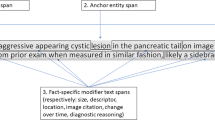Abstract
Purpose
Extracting information from electronic medical record is a time-consuming and expensive process when done manually. Rule-based and machine learning techniques are two approaches to solving this problem. In this study, we trained a machine learning model on pathology reports to extract pertinent tumor characteristics, which enabled us to create a large database of attribute searchable pathology reports. This database can be used to identify cohorts of patients with characteristics of interest.
Methods
We collected a total of 91,505 breast pathology reports from three Partners hospitals: Massachusetts General Hospital, Brigham and Women’s Hospital, and Newton-Wellesley Hospital, covering the period from 1978 to 2016. We trained our system with annotations from two datasets, consisting of 6295 and 10,841 manually annotated reports. The system extracts 20 separate categories of information, including atypia types and various tumor characteristics such as receptors. We also report a learning curve analysis to show how much annotation our model needs to perform reasonably.
Results
The model accuracy was tested on 500 reports that did not overlap with the training set. The model achieved accuracy of 90% for correctly parsing all carcinoma and atypia categories for a given patient. The average accuracy for individual categories was 97%. Using this classifier, we created a database of 91,505 parsed pathology reports.
Conclusions
Our learning curve analysis shows that the model can achieve reasonable results even when trained on a few annotations. We developed a user-friendly interface to the database that allows physicians to easily identify patients with target characteristics and export the matching cohort. This model has the potential to reduce the effort required for analyzing large amounts of data from medical records, and to minimize the cost and time required to glean scientific insight from these data.



Similar content being viewed by others
References
Buckley JM, Coopey SB, Sharko J, Polubriaginof F, Drohan B, Belli AK, Kim EM, Garber JE, Smith BL, Gadd MA et al (2012) The feasibility of using natural language processing to extract clinical information from breast pathology reports. J Pathol Inform 3:23
Edwards GA (2008) Expert systems for clinical pathology reporting. Clin Biochem Rev 29:S105–S109
Napolitano G, Fox C, Middleton R, Connolly D (2010) Pattern-based information extraction from pathology reports for cancer registration. Cancer Causes Control 21:1887–1894
Nguyen A, Lawley M, Hansen D, Colquist S (2011) Structured pathology reporting for cancer from free text: lung cancer case study. Electron J Health Inform 7:8
Nguyen AN, Lawley MJ, Hansen DP, Bowman RV, Clarke BE, Duhig EE, Colquist S (2010) Symbolic rule-based classification of lung cancer stages from free-text pathology reports. J Am Med Inform Assoc 17:440–445
Weegar R, Dalianis H (2015) Creating a rule based system for text mining of Norwegian breast cancer pathology reports. In: Sixth international workshop on health text mining and information analysis (Louhi). p 73
Li Y, Martinez D (2010) Information extraction of multiple categories from pathology reports. In: Australasian Language Technology Association Workshop. p 41
Martinez D, Li Y (2011) Information extraction from pathology reports in a hospital setting. In: Proceedings of the 20th ACM international conference on information and knowledge management, ACM. pp 1877–1882
Nguyen A, Moore D, McCowan I, Courage M-J (2007) Multi-class classification of cancer stages from free-text histology reports using support vector machines. In: 29th annual international conference of the IEEE engineering in medicine and biology society, IEEE. pp 5140–5143
Wieneke AE, Bowles EJ, Cronkite D, Wernli KJ, Gao H, Carrell D, Buist DS (2015) Validation of natural language processing to extract breast cancer pathology procedures and results. J Pathol Inform 6:38
Schapire RE, Singer Y (2000) Boostexter: a boosting-based system for text categorization. Mach Learn 39:135–168
Ou Y, Patrick J (2014) Automatic population of structured reports from narrative pathology reports. In: Proceedings of the seventh Australasian workshop on health informatics and knowledge management, vol 153, Australian Computer Society, Inc. pp 41–50
Author information
Authors and Affiliations
Corresponding author
Rights and permissions
About this article
Cite this article
Yala, A., Barzilay, R., Salama, L. et al. Using machine learning to parse breast pathology reports. Breast Cancer Res Treat 161, 203–211 (2017). https://doi.org/10.1007/s10549-016-4035-1
Received:
Accepted:
Published:
Issue Date:
DOI: https://doi.org/10.1007/s10549-016-4035-1




